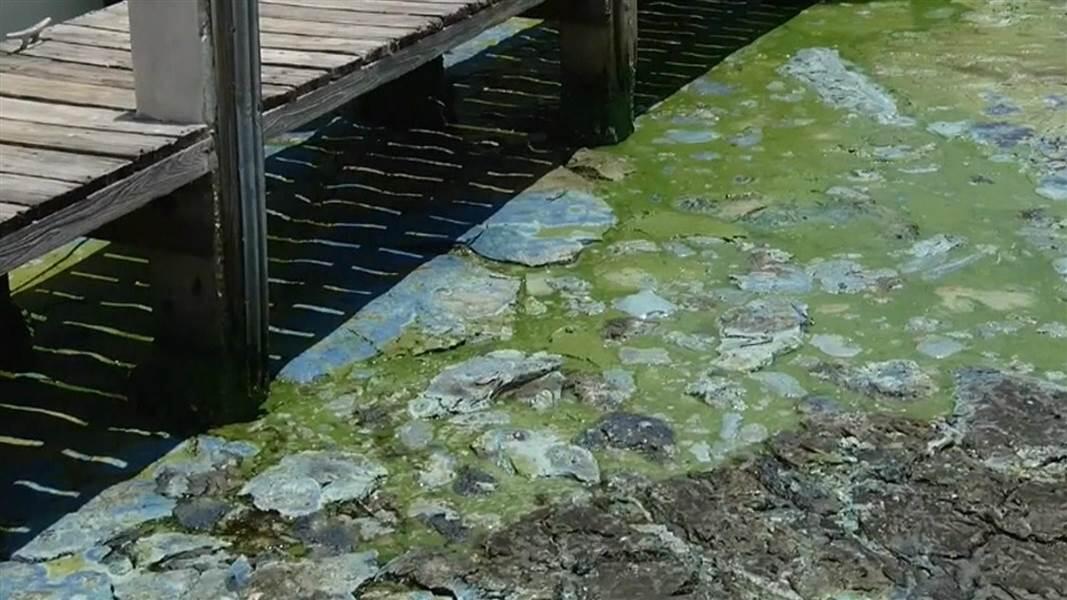Every night Tim Robinson sleeps in his boat, which floats atop a blanket of foul-smelling bright green slime.
For houseboat dwellers like Robinson, the toxic algae bloom spreading through Florida’s Lake Okeechobee — the nation’s second-largest freshwater lake — is more than just unpleasant. It’s alarming.
“We don’t know if we should be breathing this,” the 53-year-old Stuart resident told AFP. “I sleep on top of it every night.”
Robinson’s two teenage boys haven’t stayed with their father in two weeks for fear of the algae’s effects.
“It’s so depressing,” he said. “Everything we do is in the water and on the water.”
Stuart, a town on east Florida’s Treasure Coast, is about 175 kilometers (110 miles) north of Miami. It’s often cited as one of America’s best small tourist towns, particularly for its tropical climate and proximity to the St. Lucie River.
The turquoise canals, streams and lakes that zigzag among Stuart’s islands make this small town a nirvana for beachcombers and water sport lovers.
But the thick layer of slimy blue-green algae — also called cyanobacteria — coating the water and smelling of sewage has dampened the town’s appeal.
Robinson’s leathery, weathered skin glistens with sweat as he cleans the driveway of one of the area’s many marina hotels.
“I’ve got to do something to get extra money,” he said, to offset the plunge in boat rentals that are his main source of income.
Tourist Season Woes
The putrid algal blooms, which appear mornings and evenings with the rising tide, are toxic and can cause rashes and respiratory problems.
“The economic consequences are grave and ongoing,” said Sarah Heard, the commissioner of Martin County, the district that includes Stuart.
This past weekend several beaches in the county closed during the Fourth of July celebrations.
The bacteria’s proliferation has already started hurting businesses that rent kayaks, paddles and water skis, though it’s still too early to have hard figures.
“Marine-dependent businesses have failed, and more will collapse in this emergency,” said the commissioner.
U.S. Senator Marco Rubio announced Wednesday that impacted small businesses will be eligible for disaster loan assistance until Nov. 17 of this year.
I have seen firsthand how this algae crisis has affected far too many people and their livelihoods,” Rubio said in his statement.
Marine Life Graveyard
Last week the state’s governor Rick Scott declared a state of emergency in the counties of St. Lucie, Palm Beach and Martin in east Florida, and Lee on the state’s west coast, all counties with waterways that take excess drainwater from the central Lake Okeechobee.
Much of the problem in area rivers stems from the fact that the lake’s aging dike is too weak to manage high lake water levels. During the rainy summer season authorities must therefore pump water out of the lake into nearby rivers, ensuring that the algae will spread, as it has been doing since mid-May.
Scott has also urged President Barack Obama to declare a federal emergency over the spread of the algae blooms — blaming federal authorities for the condition of the dike.
According to studies by the state’s Department of Environmental Protection, some affected areas have 38 times the maximum limit of cyanobacteria accepted by the World Health Organization, 10 micrograms per liter.
The organism occurs naturally, but its growth is exacerbated by an influx of nutrients like phosphorus and nitrogen, commonly found in agricultural fertilizers.
“When you supply phosphorus and nitrogen, algae grows and reproduces exponentially, causing a bloom,” said Henry Briceno, a geologist at Florida International University.
Briceno told AFP that the fertilizer used in the area for farming, gardens and golf courses are to blame for an excess of phosphorus in the lake.
The toxic bacteria outbreak poses threats to human health and the area’s economy, but for aquatic life, cyanobacteria can prove fatal.
The thick sludge suffocates seagrasses by blocking sunlight from penetrating the water.
Algae also kills sponges, oysters and other sea creatures integral to water filtration.
“There comes a time when the water can no longer sustain life,” said Briceno.
Source: AFP











